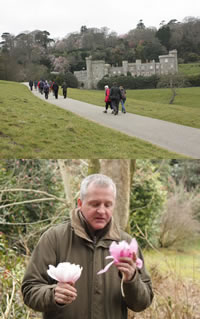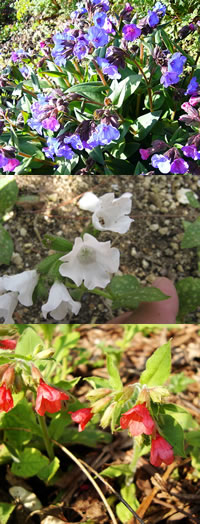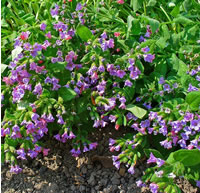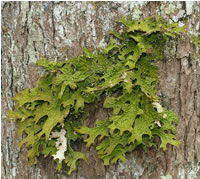This month sees the closing date on 18 April for applications for this year's David Miller Travel Bursary Award. Thanks to continuing support from Vitacress , The Eden Project and the help of a new sponsor, The Eric Gardener Memorial Fund, we are able to offer two awards of £500 each this year. Applications are still invited from students in the second or final year of a higher education qualification (BSc, HND, Kew Diploma etc) or studying for an MSc or PhD. Applicants must be students registered for courses in the UK or the Republic of Ireland. Applications close on 18 April 2016.
Looking back it was great to see Idowu Rotifa, a 2015 winner of the David Miller Travel Bursary Award winner appear on the front cover of last month's AHDB News.
In March PHGSW organised their usual three day meeting in the depths of the south-west. This year's meeting was based around Redruth, St Mawes and Mevagissey and the first part is reported on below.
This month we are heading to Sherbourne Turf on 28 April followed by a visit to Pearce seeds, a company founded on grass seed production but now producing a wider range of agricultural seeds and supplies.
Other events in April include the UK Plant Science Federation Conference on 11 - 12 April, the Day of Science and Careers on 13 April.
Peter Grimbly
Contents
Magnolias and Camelias from Tin
Plant of the Month
News from our Associates
Horticulture Industry News
Events Calendar
Horticulture Group contact details
Related Links
Magnolias and Camelias from Tin
The Williams family were one of the wealthiest in Cornwall coming originally from Shropshire in the 17th century to profit from the developing metal mines. They settled in the Gwennap area, near Redruth, prospered and their descendents purchased Burncoose House in 1715, built nearby Scorrier House in 1778, and bought the Caerhays estate in 1853. All three houses now boast notable gardens although only Burncoose and Caerhays are open to the public; Scorrier being retained as a wedding and event venue. All three gardens benefit from the mild Cornish climate and acid soils which has made them ideal for the Camellias and Magnolias for which they are famous.
Burncoose

While describing the merits of the many Camellias being grown Andrew pointed out that while Camelia japonica becomes pale in the sun the Williams bred Xwilliamsii hybrids (Camellia japonica X C. saluenensis) retain a good strong green colour. They also drop their flowers when they are finished while C. japonica hybrids retain the dead flowers which hang on to the plant like ‘a wet tea bag’ as Andrew put it.
The new varieties have created the demand and the nursery has developed over the last thirty years to propagate and market them as well as other species in demand. Many of the Magnolia hybrids are sold as grafted plants on a Magnolia kobus rootstock. The grafting is done by a Swiss nurseryman who takes Cornish grown scions, grafts them onto M. Kobus and then returns the grafted plants to Burncoose for growing on. More material of Camellia, Magnolia and Acer varieties is bought in from New Zealand. Once potted and rooted they are ready for sale either through the nursery or via mail order or for the nursery’s well-known stands at Chelsea and other flower shows.
Caerhays

Caerhays is noted for its collection of around 800 Magnolias as well as a National Collection of Podocarpus. The Magnolias have been collected over generations while the Podocarpus and some other fledgling collections arise from the interests of the present owner.
The gardens coastal location means protection from wind is essential and this has been achieved with pines and yews. The pines have now reached old age and are in need of replacement but the yews, because they regenerate freely, are being pollarded.
The 800 varieties of Magnolia form the basis of their on-going breeding programme. Jamie demonstrated the hybridisation technique using two seedlings selected from a cross between M. sargentiana 'Robusta' X M. sprengeri 'Diva' the former with a cup shaped flower and the latter more open and reflexed. Pollination is simple and the seed yield is not high. However, the seedlings can take ten or more years to flower and two or three more years before the true flower characters are seen. There is not sufficient space to grow them all on to flowering so much of the early selection is done on vegetative characters and only the one or two survivors have a chance to show their true flowering characteristics.
Given the family connection with tin mining we were not surprised to find a ‘tin garden’ marked on the garden map. On arrival at the site Jamie explained the area, currently under development, was originally used for pheasant rearing and the name derived not from the mining activities of the family but from the tin cans used to scare off predators.
Adjacent was a hitherto unused area of the main garden which has recently been planted up and will provide additional space for the further development of the Caerhays magnolia collection.
Peter Grimbly
Plant of the Month

In spring borders, with most of the colour coming from bulbs on upright stems, it is useful to have some horticultural 'fluff' or 'filler' to provide some ground cover and mid-level colour, and Pulmonaria does the job very well. With a range of flower colour, from white through the usual blue/pink of Boraginaceae through pale pink to red, there are plenty of cultivars and species to choose from. The RHS Plant finder lists 227 taxa, with seven having been given the Award of Garden Merit (including those featured in the title above).
The main species used horticulturally are Pulmonaria saccharata, P. angustifolia and P. longifolia together with P. rubra (picture lower right by IKAI). The genus of about 15 species originates mainly from Europe and western Asia with one species (P. mollis) from farther east in central and eastern Asia. The genus, like many other in the Boraginaceae is characterised by its rough hairy leaves and flowers that turn from pink to blue as they mature. The flowers also exhibit heterostyly, just as the primrose and other primula do. This means that there are two distinct forms of flower within each species, with individual plants only exhibiting one kind of styly. Known colloquially as pin and thrum, on heterostylous flowers of the pin type the stamen are short and the styles long, whilst the thrum type flowers have long stamen and short styles.
The changing flower colour has been shown to influence pollinator visits to the flowers. The young red flowers have a greater pollen and nectar reward for visiting pollinators and although at a long distance pollinators appear to be equally attracted to both red and blue flowers, once they are up close they preferentially choose the red flowers. The authors propose that by maintaining both flower colours, they increase overall attractiveness, but direct pollinators for maximum reward.
Picture - top right - Pulmonaria ‘Blue Ensign’ by Magnus Manske
Picture - middle right - Pulmonaria ‘Sissinghurst White' by KENPEI
Reference: Floral colour change and the attraction of insect pollinators in lungwort. Oecologia, November 1999, Volume 121, Issue 3, pp383-391.
Alison Foster
Royal Botanic Gardens Kew
Medicinal Plant of the Month
Pulmonaria officinalis, common lungwort, Boraginaceae
(pictured right by H Zell)

The Doctrine of Signatures was promoted by Paracelsus (1491-1541) who wrote that 'Nature marks each growth …..according to its curative benefit'. Other proponents of the theory suggested that God marked plants with a sign so that humankind would know of their usefulness. Indeed, Jakob Böhme wrote a book entitled The signature of all things, published in 1621 which lent its name to the doctrine.
Of course, more recent scientific study has been shown not to 
However, as with many common names, care must be taken as the common name lungwort also applies to a lichen (Lobaria pulmonaria pictured right by Bernd Haynold) which is used by herbal practitioners for the treatment of similar lung conditions.
Alison Foster
Royal Botanic Gardens Kew
News from our Associates
Commercial Horticultural Association

UK Plant Science Federation

Horticulture Industry News
For the very latest horticultural news follow us on Facebook,
Twitter, or
LinkedIn
Kew Gardens - a classroom for the world
But now a new vision for Kew Gardens is to be revealed. At its centre will be a giant beehive (open later this year) where visitors can experience the sounds and habits of a colony of bees and a newly refurbished Temperate House (Opening May 2018) showcasing the world’s most threatened and endangered species. The new look Kew will also see the opening of a children’s playground garden allowing them to explore and learn about plants 'hands-on' and an annual science festival for youngsters. It is part of a vision to transform the Royal Botanical Gardens into a giant outdoor classroom and laboratory, teaching both children and adults the importance of plant diversity in saving the planet. The director of Kew, Richard Deverell, is determined to harness the scientific resources of the gardens to help shape the British public's awareness of the fundamental role played by plants and fungi in keeping us alive - and how the threat to bio-diversity will impact on mankind's future.
Missing crops
New research has revealed significant gaps in the world’s genebanks. This is both in terms of species and regions with over 70% of essential crop wild relative (CWR) species in need of urgent collection including banana, plantain and sorghum. This is the first time a global 'atlas' will be available for plant scientists, conservationists and funding agencies to find out which crop wild relatives should be collected, and where. The study mapped 1,076 CWR of the world’s 81 most important crops for food security and compared predicted CWR distributions with records from the world’s major genebanks. The results provide the most comprehensive list of gaps within collections of CWR species currently in place, and show that 29% (313) of the wild relative plant species analysed, are completely missing from the world’s major genebanks. Furthermore, 23.9% (257) of species are represented by fewer than 10 samples, leaving out a substantial amount of potentially important plant diversity. In total over 95% are insufficiently represented, in terms of geographic range and ecological variation in their native distributions.
Preventing biodiversity loss due to ash dieback disease
A new study of woodlands across the UK reveals that, as Chalara ash dieback disease progresses, encouraging the growth of other broadleaved trees as alternatives could protect the almost 1000 species of plants and animals which usually use ash trees for food and habitat. In the UK alone, more than 950 different species use ash trees for food or habitat. Most of these ash-associated species are lichens, invertebrates and fungi, but they also include 28 species of mammal and 12 bird species. Now, researchers have investigated which tree species can be used as alternatives to ash, and identified the forest management strategies that would encourage these alternative tree species to grow. They found that the majority of woodlands studied already contained the alternative host trees and in most cases, following standard forestry practices would ensure the availability of the alternative host trees and improve the chances of ash-associated biodiversity surviving if ash was lost. More
Genes for plant-fungi symbiosis uncovered
A new study has uncovered a veritable trove of genes used by plants to form symbiotic relationships with fungi, vastly increasing the knowledge of the genetic basis for this agriculturally valuable interaction. Most land plants get a large portion of their mineral nutrients through a symbiotic relationship with soil fungi called arbuscular mycorrhizal (AM) symbiosis. But, despite decades of research, many of the genes required to form this relationship remain elusive. Now, with the advent of widely available genome sequences, researchers were able to compare 50 plant genomes to identify 138 genes shared exclusively by plants capable of AM symbiosis. The findings may ultimately bring us closer to developing plants that thrive without added fertilizer. More
Phoney peach on the march ...
The UK is on red alert for signs that Phoney Peach Disease caused by Xylella fastidiosa has entered the country. First confirmed in Europe it has already caused severe damage to plants and trees in the US and southern Europe and now there are fears it is heading this way with experts warning that it could make the devastating ash dieback disease seem like “a walk in the park”. Three years ago it ran rampant across olive plantations in southern Italy, a subspecies of Xylella has since been detected in southern France, where it has destroyed vines and lavender plants, and in Corsica. Xylella fastidiosa has also been found in both South and North America where it has caused severe damage to citrus and coffee plantations. In New Jersey it has attacked more than a third of the state’s urban trees. According to guidance issued by the Department for Environment, Food and Rural Affairs (Defra), Xylella has already infected oak and maple trees, hebe (an evergreen shrub), lavender and rosemary. It results in multiple symptoms, including wilting, diebacks, stunted growth and leaf scorches. More
... however some olives are tolerant
Tests suggests some varieties of olive trees appear to be resistant to Xylella fastidiosa which is a serious risk to Europe’s olive industry. The findings came to light during a study into the host range of the bacterium, which reached Europe in 2013. The findings offer hope of limiting the impact of what experts described as one of the 'most dangerous plant pathogens worldwide'. The study, carried out by Italian researchers and funded by the European Food Safety Agency (EFSA), began in 2014 and consisted of two main types of experiment: artificial inoculation (via needle) and inoculation via infected vectors (insects) collected from the field. The tests were carried out on a variety of species, including a range of olive, grape, stone-fruit (almond and cherry) and oak varieties. What has also been shown is that some varieties have shown some tolerance. They grow in infected orchards but do not show strong symptoms, as seen in more susceptible varieties. They are still infected by the inoculation but this infection is much slower so it takes longer for the infection to spread, and the concentration of the bacterium in the plant is much lower. More
Events Calendar
SCI Horticulture Group events are listed here
Other Events of Interest:
Induced Plant Development
4 - 6Apr 2016, Sainsbury Laboratory
Cambridge, UK
Molecular Encoding of Specificity in Plant Processes
4 - 6 Apr 2016, University of Tubingen
Tubingen, Germany
Root Phenotyping
7 - 8 Apr 2016, UK Plant Phenomic Network
Nottingham, UKBiotechnology of Fruit Species
Vaccinium
10 - 14 Apr 2016,
Orlando, USA
The Root Zone: Soil Physics and Beyond
10 - 14 Apr 2016, Soil Science Society of America
Sede Boqer, Israel
Organic Greenhouse Horticulture
11 - 14 Apr 2016, European Cooperation in Science & Technology
Izmir, Turkey
Plants in a changing world: molecule to ecosystem
11 - 12 Apr 2016, UK Plant Science Federation
Norwich, UK
Pulses for Health, Nutrition and Sustainable Agriculture in Drylands
13 - 15 Apr 2016, ICARDA
Rabat, Morocco
Biotechnology of Fruit Species
27 Apr 2016 - 1 May 2016, International Society for Horticultural Science
Antalya, Turkey
State of the World's Plants
11 - 12 May 2016, Royal Botanic Gardens Kew
Kew, UK
Post Graduate Horticulture Scientists
12 - 13 May 2016, International Society for Horticultural Science
Palermo, Italy
Plant developmental evolution
15 - 19 May 2016, New Phytologist Trust
Beijing, China
Role of Plant Genetic Resources on Reclaiming Lands and Environment Deteriorated by Human and Natural Actions
16 - 20 May 2016, Plant Genetic Resources Commission of International Society for Horticultural Science
Shiraz, Iran
Light in Horticulture
22 - 26 May 2016, International Society for Horticultural Science
East Lancing, USA
Floral Biology and S-Incompatibility in Fruit Species
23 - 26 May 2016, ISHS Commission of Molecular Biology
Murcia, Spain
International Cool climate Wine Symposium
26 - 28 May 2016
B righton, UK
Iron Nutrition and Interactions in Plants
30 May 2016 - 3 Jun 2016,
Madrid, Spain
Lychee, Longan and Other Sapindaceae Fruits
31 May 2016 - 3 Jun 2016,
Sabour, India
How Plants Sense, Process, Integrate and Store Information
12 - 17 Jun 2016, Gordon Research Conferences
Holderness, USA
Tomato Diseases
13 - 16 Jun 2016, International Society of Horticultural Science
Malaga, Spain
Grapevine Physiology and Biotechnology
13 - 18 Jun 2016, International Society of Horticultural Science
Verona, Italy
Plant Biology for Sustainable Living
15 - 19 Jun 2016, Norwegian University for Science and Technology
Trondheim, Norway
Plant Biotech
19 - 21 Jun 2016, Canadian Association for Plant Biotechnology
Kingston, Canada
Landscape and Urban Horticulture
20 - 25 Jun 2016, International Society of Horticultural Science
Athens, Greece
Enhancing supply chain and consumer benefits: ethical and technological issues
21 - 24 Jun 2016, International Society of Horticultural Science
Cartagena, Spain
Plant Growth Substances
21 - 25 Jun 2016, The International Plant Growth Substances Association
Toronto, Canada
Virus Diseases of Ornamental Plants
26 - 29 Jun 2016, International Society of Horticultural Science
Singapore, Singapore
Exploiting novel sensors for detecting abiotic and biotic stress in crops
27 - 28 Jun 2016, Association of Applied Biologists
Sutton Bonnington, UK
Flower Bulbs and Herbaceous Perennials
28 Jun 2016 - 2 Jul 2016, International Society of Horticultural Science
Kunming, China
Arabidopsis Research
29 Jun 2016 - 3 Jul 2016
Gyeong Ju, Korea
Horticulture Group Contact Details
For submitting ideas or to volunteer to be part of a committee or a group, please contact:
Chairman - Tony Girard
Meetings Coordinator - Peter Grimbly
Minutes Secretary - Margaret Waddy
Newsletter co-ordinator - Sue Grimbly scihortigroup@btinternet.com
